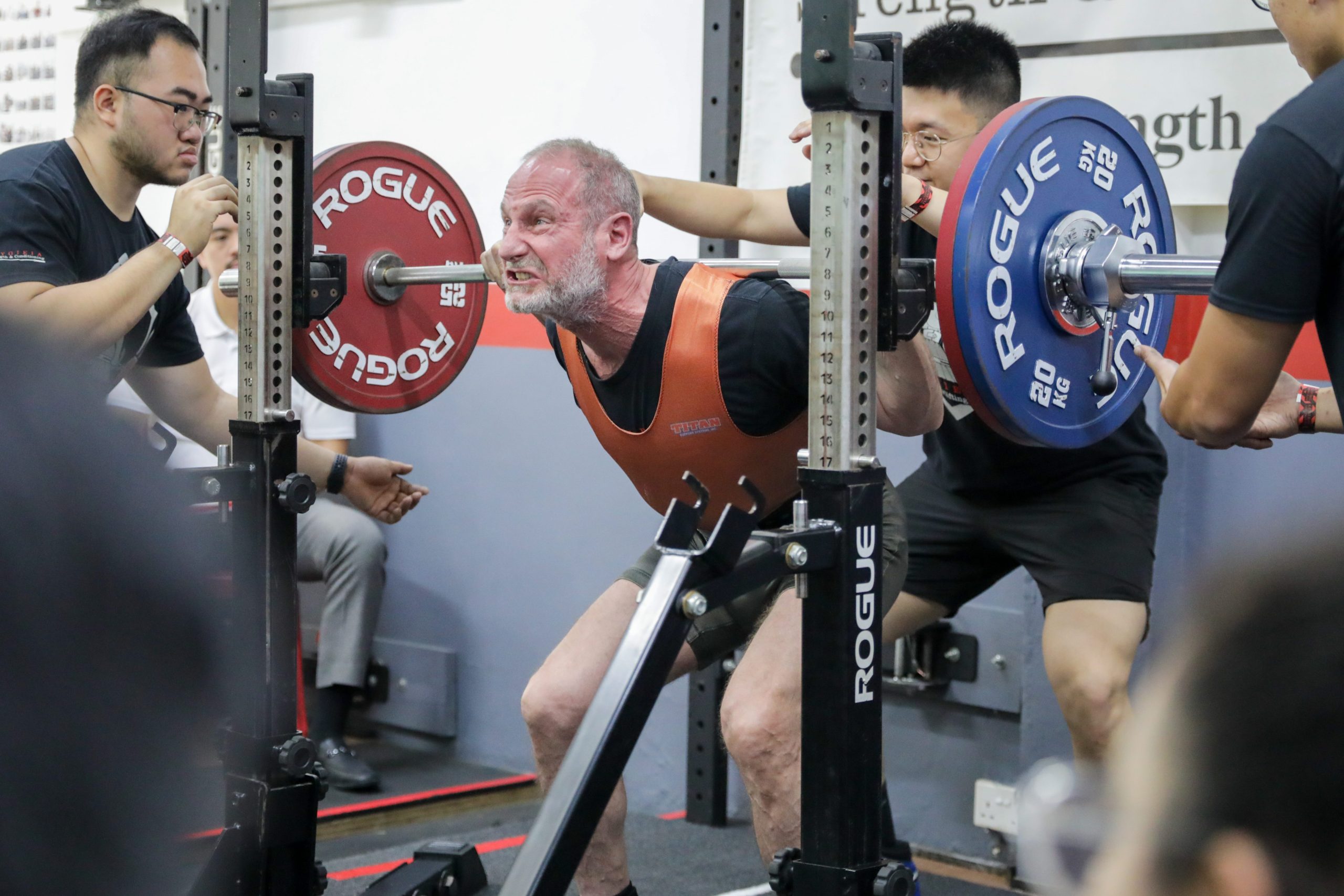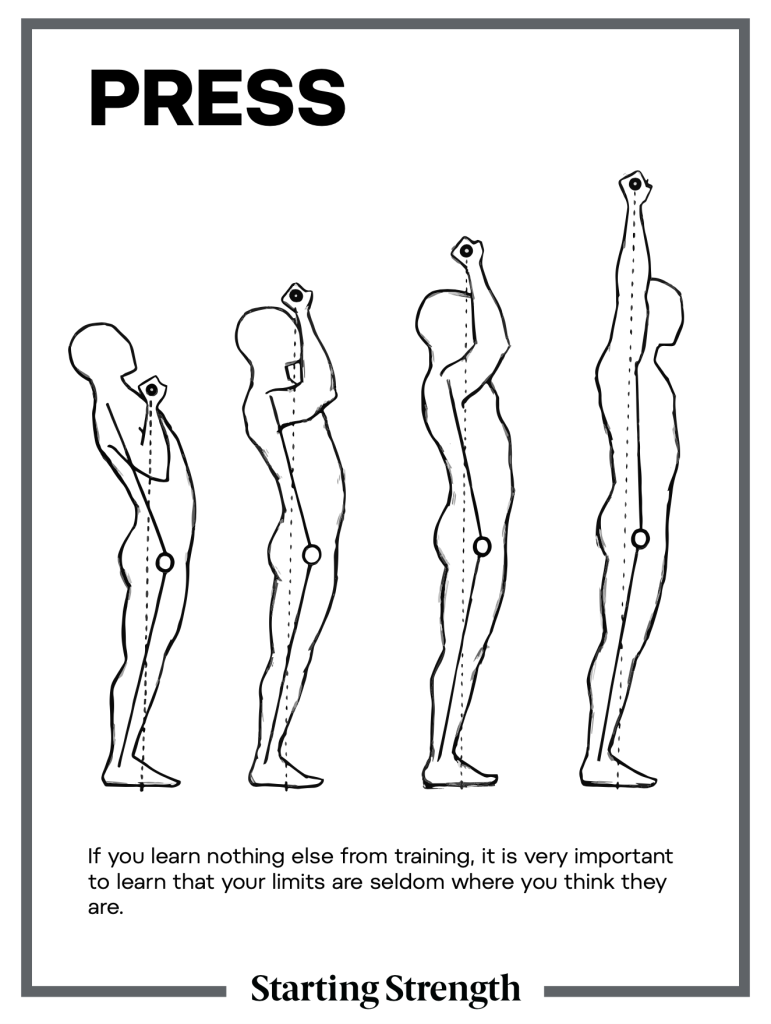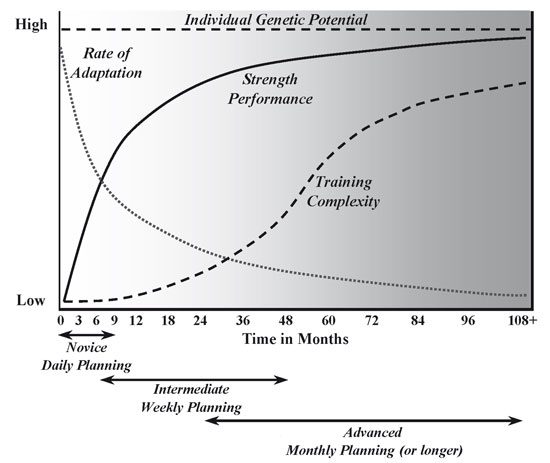
Over the years, we’ve run hundreds of client through their novice linear progression (NLP). Occasionally, we’d have a client say, “That felt super heavy. I think I’ve reached my max and don’t think I can lift more than that”. This usually happens after completing a really hard set, somewhere near the end of their NLP.
For them, that last set just felt so overwhelming that they can’t even fathom how they could add more weight to the bar the next session and lift it.
Now, we know that’s not the case. We know that they’ve actually got a long way to go. But in their minds, that last set was the heaviest thing they’ve ever lifted, the hardest physical thing they’ve ever done. It was already such a struggle. How can they do more? It’s just impossible.
Well, in our gym, there’s a Starting Strength poster on the wall. The caption reads: “If you learn nothing else from training, it is very important to learn that your limits are seldom where you think they are”.

As coaches, we can speak to the truth of this statement. It might feel like you’ve hit your max, but what you feel isn’t accurate at all.
As you progress, training feels harder
If you focus just on a single session, it may very well be true that you might actually be hitting your limits. The problem of drawing a conclusion from a single day of training is that it’s an inaccurate assessment. Remember, training is physical activity done with a long-term goal and is made out of a series of workouts designed to produce the training stress to achieve a goal.
You need to look at your training as a whole. While that heavy set of squats may be hitting your limit FOR THAT DAY, you’re forgetting that you’ll recover from that day’s workout, adapt to the training stress and get a little stronger. This is the basic Stress-Adaptation-Recovery cycle.
On day one of training, you started with weights that were slightly challenging and added weight to the bar on every session. As you progress, get stronger and approach the end of your NLP, the gainz train gradually slows down. The honeymoon phase of fast gains and “easy” training sessions are over.
To keep getting stronger, your training program needs to evolve and account for the increase in training stress needed – this means an increase in either intensity and/or volume. Training will keep getting harder and harder.
In a nutshell, the stronger you are, the more training stress and time are required to keep increasing your strength.

For every lifter who thinks they can’t lift more – keep on training and pushing yourself. Every single one of our clients who kept training consistently got stronger and continued to get stronger. And they’re always pleased when they realise that a weight that used to feel super heavy is now a warm-up.
How it feels ≠ how it looks
While it can feel freaking impossible sometimes, let’s look at the visual evidence.
From our perspective as coaches, when a lifter tells us that it feels super hard, it can look very manageable to us. Now if they could see themselves from a third person’s point of view, they’d also agree that it looks manageable.
To prove that, we’ll ask them to video themselves doing that crazy difficult set. After reviewing the video, they always agree that it actually looks… fine. They’ll be kind of surprised, and say something like, “Oh yeah, that actually looks pretty ok, but it feels so damn hard though. Totally not like how it feels at all.”
Even I get that. Sometimes I’ll feel that a set was particularly hard or the bar moved very slowly. But when I review my video, it turns out that’s not the case at all. How the bar moved wasn’t anything close to what it felt like.
How it feels doesn’t necessarily equate to how it actually is. Over time, and as you get more experience under the bar, you’ll get a better sense of how easy or hard the set was but what you feel isn’t always an assessment of what’s going on.
Almost always without fail, a lifter will perceive the lift to be harder than it actually is. This phenomenon not only occurs to novice lifters, but also to advanced lifters who have been training for years.
Don’t miss out on potential PRs
Recently, I coached a client who competed at the World Masters Powerlifting Meet in Mongolia. On the squat, he opened comfortably with 220 kg. Moving fast, I called for the next increment – 232.5 kg for his second attempt.
After stepping off the platform, he said that it felt very hard. He was very close to his limits and didn’t have much left. Because he felt this was pretty much his max, he wanted to forfeit the last attempt to save energy for the deadlift.
However, I knew that he could do more. So I politely ignored his request to forfeit the third, walked up to the score table and submitted 237.5 kg for his third attempt. Thankfully, he trusted my judgement and agreed to give it a shot.
While resting and waiting for his turn, I gave him a cue to focus on for the third attempt. His name was called to the platform. He walked up to the rack, unracked the bar, took a big breath, started his descent….and came up at almost exactly the same bar speed!
Had he decided to listen to what his brain told him, he would have missed out on adding another 5 kg to his squat, and bringing his PR and the Singapore national record to 237.5 kg. Granted, he’s only been competing for the last 2-3 years. But while he’s not a super experienced competitor with decades of experience under his belt, he’s not a novice by any means. It just goes to show that limits are often self-imposed.
How to overcome self-imposed limits
The simple answer is, just do it. While cliché, it’s the only way to find out if you’re able to do it.
Remember, your mind will trick you. Unless you’re pretty Zen, perceived intensity is probably not accurate and fear of injury can dent your confidence.
So the first thing to do is get out of your head, focus on one task or cue, and give it everything you’ve got!
It really is that simple. No matter what, you have to give it a shot. Say you’re squatting a heavy set of 5, and it already feels pretty damn hard and quite a fight to stand back up on rep 4. You start thinking, “Oh man, that was super hard. I’m not sure if I can do the 5th rep. Should I rack the bar or give it a try?”
The answer is you should always try. And while the last rep may be a huge fight, you’d have learnt something about yourself – that your limits are not where you thought they were.
Don’t underestimate yourself
We grow by overcoming our perceived limits.
If you didn’t give it a shot and decided to rack the bar back, you’ll have not only missed out on the training stimulus, but more importantly, a lesson about life – how to try and push through when things are hard.
And even if you missed the rep, you would have learnt something about yourself, what you’re made of and honed your mental strength to do difficult things.
Try it, you’ll be glad you did.
Our gym is a place to get strong, both physically and mentally. If you think you’ve hit your limits, train with us and we’ll show you how much more you’ve got.

